A few years ago "Motorcycle Rider", (the British Motorcycle Federation magazine), ran a series of articles on the "Eco Worthiness" of various machines. I have reproduced the bulk of the MZ related one.
Stephen Kearney wrote:The MZ Supa 5 (TS 250/1) came out in 1975. This was the first bike that got MZ accepted as a serious contender, at least as far as we are concerned. Before that their decidedly odd shape and apparent irrelevance seemed to sideline them to the more eccentric end of the bike market. While one might complain about the looks of the Supa 5 also, I find its functional style quite attractive. Maybe I'm just joining the eccentrics. Although never having owned one, I have some knowledge of the Supa 5, having shared a flat with twin brothers who operated one apiece as dispatch riders for five years. Further, more information was offered by another DR with a 1989 ETZ 250, bored out to 300cc. Road tests at the time generally reckoned that it was quite good for what it was and particularly commended its bright lights, despite being only six volts. One magazine said they were so good they didn't need 12 volts.
For reasons best known to himself, Twin No 1 decided to go dispatching and in
1979 bought himself a new Supa 5 for about £500: all black and chrome, just
like a Vincent (ahem). It seemed like an excellent bike right from the start,
and we couldn't believe how bright the lights were. The whole bike displayed a
quality of functional concept and execution and was pleasurable to ride too. If you need this point demonstrated, try a CZ 250 from Czechoslovakia, a country then operating under the same socio-economic system as the former East Germany. The CZ was of similar specification: 250cc two-stroke single, petroil mix, intended for rugged transport. You'd imagine therefore that the two machines would be pretty similar to ride: not a bit of it. The designer of the CZ clearly intended that nobody should ever get any pleasure out of riding it - and he succeeded! Twin No.2 decided to follow the family career and bought an 11,000-mile Supa 5 for around £200. Both twins then dispatched merrily away. At 14,000 miles the main bearings on twin 1's MZ gave up, signalled by a very noisy engine. So the rumours were true! Folklore at the time suggested that poor quality East German (some even said Russian) bearings were the reason. Mind you, I knew a chap who got all of 2,000 miles out of a brand new Norton Commando before its mains failed, in Paris. We decided to try British bearings and these were duly installed. They failed at 16,000 miles; so much for folklore. We had to try something different. The recommended petroil mix for the Supa 5 is 50:1, which is remarkably lean for a simple two-stroke. My old Bantam, for instance, used to run on 20:1 and smoked to prove it. A friend who used to run his Lambretta on 16:1 suggested 33:1 for the MZ, so this was tried along with another set of British mains. That set was still going strong when the bike was sold 60,000 miles later. Twin 2 had a similar story. His mains failed at 13,000 and the selling dealer, an MZ agent, was baffled, particularly as the engine sounded so well at 11,000. New bearings were installed and a switch made to a 33:1 mix. No further bearing problems were encountered and the momentary piston seizures that occurred from time to time on the old mix ratio now disappeared. Some suggested it was the West's pollution laws which forced the MZ factory into recommending such a lean mix, but when I checked in the MZ shop in East Berlin in 1982 they told me that the recommended mix for them was 50:1 too. When I recounted our experiences, they were stumped. They had never heard of dispatch riders, by the way. For general running and dispatching, both Supa 5s were well up to the job, providing reliable service under rough conditions with patchy and amateurish maintenance.
The single leading shoe front brake wasn't strong enough for city dispatch work; in fact, both twins complained that it was downright dangerous. The Supa 5 remains, however, the most rust-resistant bike I have ever seen. The shortcomings mentioned above have been largely overcome with the ETZ250, which boasts a disc front brake and 12-volt electrics. With over 30,000 miles, no main bearing faults were reported. It has an autolube system but I'm not sure if this is the reason. 1. Fuel consumption: 5/10Our list calls for 80mpg at an easy 70mph. I'm afraid no MZ gets near this; 50mpg if you're lucky and a lot worse if you thrash it - down to 40mpg. Gentle cruising can improve things. I've also heard that if the new 300cc versions are fitted with raised gearing they can improve on that 50mpg figure. It is one of the inherent weaknesses with two-strokes that they guzzle the juice when opened up. This is partially compensated for by an engine which is lighter, cheaper and simpler, and does away with oil changes. 2. Oil consumption: 1/10This is a bit tricky, being a two-stroke, but let's not lose sight of the grand objective - less consumption. The target is 2,000 miles per litre so the MZ falls well short: 2,000 miles at 50mpg = 40 gallons at 33:1 = 5.5 litres. 3. Oil changes: 10/10It hardly applies here but that's no reason to fail to credit it. 4. Tyre life: 1/10Once the originals have been junked for their poor grip, tyre life is not too bad. It's difficult to be exact because I've got three sets of figures, but 18,000 miles for the front and 9,000 for the rear seems about average. 5. Chain life: 9/10
Maybe I'm being a bit too generous in marking here, but it seems that once you've got a decent chain, it lasts a long time. Nine points covers all three bikes, but I'm sure many MZs would earn 10. 6. Ancillary component life: 7/10Going over the figures, it looks like the Supa 5 is lighter on ancillaries than the ETZ. Is this progress? The ETZ averages about 6,000 miles to a set of front brake pads and 12,000 miles per set of rear brake shoes. Clutch cables don't seem to last any longer. Spark plugs last 5,000 miles, which is what you'd expect from a two-stroke. Looking at the Supa 5 figures, some improvement is revealed but the same sort of things fail; nothing too dramatic, but a bit disappointing. Stop light switches gave constant trouble on both bikes. It must be pointed out that all the 'test' bikes were used for dispatching and that chews through components. 7. Engine life before head removal: 5/10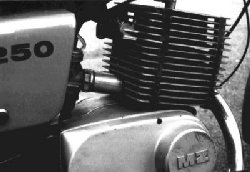
This score is either too high if you consider the earlier experiences, or too low if you concentrate on the latter. Once properly set up, they seem to run for at least 50,000 miles before any strip down is required. Twin no.1 did have a gearbox seize at speed with about 50,000 miles up. A broken pinion was the cause. Treated gently and not dispatched, 100,000 is conceivable, but I'll stick to 5/10. 8. Maximum weight: 10/10The MZ weighs in at about 3001b, well below target. It is easy to manhandle and quite an acceptable weight for what it is. Alloy rims help. 9. Repair and maintenance: 9/10No machine is perfect here, but this must be close. It's simple and straightforward and, backed up by thorough and realistic Teutonic design, little maintenance is needed. Use of high quality metal and castings, which incidentally minimises corrosion, also helps. There is one stupid fault: if the gear lever return spring breaks, as it does from time to time, a complete engine strip is necessitated unless you want to develop a smart foot. This feature is shared with the BSA Bantam, you'll be pleased to hear. 10. Production life: 8/10The MZ 250 of one type or another stretches way back. The factory seems to have a policy of slow and careful development, which is just the thing for an eco-biker. While the Supa 5 is out of production, bits are easily available. The ETZ series looks likely to stay around for a while yet, so spares should present no problem even if they are more expensive in the wake of German unification. SummaryThe score comes to 71 per cent, which is adequate but could be a lot better (but see Andrew's assessment of his ETZ250). Actually, I feel this score doesn't do the MZ justice. There is a fundamental toughness and suitability for improvisation in these machines that cannot be measured by consumption figures alone. While it is weak in fuel and oil consumption, it has a durability that can obviate further purchase, so reducing consumption and pollution. Modifications available from specialist dealers offer definite improvements. A well set-up MZ can make a very fine multi-role bike with an emphasis on the practical, while still able to cruise at the legal limit. In eco terms the MZ 250 is a worthy bike. If people bought bikes to match their needs rather than their dreams, they would sell like hot cakes.
MZ Riders Club Membership Secretary (1991) Andrew Ross adds an appendix to Stephen's assessment.MANY MZ enthusiasts consider the ETZ250, manufactured for almost a decade from 1981, to be the finest motorcycle ever produced by the Zschopau works. It had stronger engine than earlier models, much improved brakes and electrics, and arguably more performance than the versions which preceded or followed it. Only the quality of finish left something to be desired when compared to the lustrous paint-work offered on the first ES models available here in the early 1970s. First and foremost the ETZ had an extraordinary versatility for its selling price of around £700 in the mid-1980's. It is equally at home as commuter, long. haul tourer, green laner, or even on the racetrack - as those in the MZ racing fraternity who have extracted speeds in excess of 115mph have discovered. Here is my eco-bike assessment. 1. Fuel consumption: 5/10As with all two-strokes, this is enormously variable. I have kept fuel record since I bought my bike new in 1984 and have obtained figures of between 30 and 80mpg. The average over 62,000 miles is 52mpg - not too good against the ecobike criterion. The tank holds just over 17 litres and range can generally be stretched to a useful 180 miles, including 20 on reserve. 2. Oil consumption: 5/10Again poor, of course, against the target. The oil pump, delivering between 30:1 and 70:1 depending on load, gives about 500 miles from its one-litre tank. 3. Oil changes: 10/10Applies only to the gear oil, which the manual recommends replacing every 12,000 miles. Wise owners do so much more often, oil being cheaper than bearings. 4. Tyre life: 10/10
5. Chain life: 8/10Full enclosure is an MZ hallmark and it certainly helps. The sprockets seem to last forever, which is just as well as the rear one incorporates the cush drive mechanism and is expensive to replace. Chains last about 15,000 miles and a heavy duty one costs less than £20. 6. Component life: 10/10In the life of the bike I have replaced one fusebox, one front brake light switch, two oil pump cables, two rev counter cables, one of the fork seals (twice), one set of engine rubber mounts and a handful of assorted bulbs and brake pads. Really no complaints here. 7. Engine life: 7/10Show me a two-stroke that hits this target! However, there are plenty of ETZ's (and other models) still running with much higher mileage than mine. Mine had a precautionary and probably unnecessary decoke at 25,000 miles before a trip to the FIM Rally in Budapest. Thereafter everything ran swimmingly until a rattling at 40,000 heralded the disintegration of a big end shim and subsequent damage to the big end bearing. This led to one of the bike's two journeys on an AA trailer. (The other followed a two-up 60mph front tyre blow-out - not recommended.) Subsequent dismantling (not by me, but somebody good at this sort of thing) revealed a damaged big end and piston, and slight wear in some of the gearbox bearings. Amazingly the cylinder liner was undamaged, and 22,000 miles on, the engine has shown no signs of needing a rebore and has needed no further attention. From my knowledge of other people's experiences, 40,000 miles seems the norm before ETZ engines need attention of some sort. This is a considerable improvement over earlier models which tended to develop rumbling big ends at around 25,000. 8. Maximum weight: 10/10A weight of 153kg makes for a manageable bike under all conditions. Even loaded with passenger and camping gear it is possible to execute U-turns in narrow lanes without embarrassment -something which could not be said of some heavier machines. 9. Repair and maintenance: 9/10Everything is simple and straightforward in concept and execution, easy to get at and easy to adjust. The only thing preventing a score of 10 is the occasional and annoying invasion of gremlins. These generally affect the electrical or ignition system of older bikes - not mine as yet. Some owners have problems setting up the enclosed rear brake light switch. Personally I think the arrangement is rather a neat solution which, once set up, works reliably. The current 251 model, however, has an exposed and less pretty spring and plunger type switch.
If the engine does have to come out for any reason, removal is possible in under an hour. The only special tool required for complete dismantling is a clutch puller. Top end access is possible without dropping the engine from the frame. 10. Production life: 10/10If the newer 251s are included, the ETZ series stretches back over 10 years. Many parts from 1970s models also fit. So second-hand spares look like being readily available for some time to come. For owners with some spare cash, now is a good time to be an MZ owner as a number of MZ emporia in the former East Germany are currently touring the European and rally circuit offloading stocks of spares at rock bottom prices. SummaryThat's 84 per cent, and not a hint of bias from a long-time MZ enthusiast! Considering the relatively low price, new or second-hand, and the almost indefinite recyclability of the machine (many MZs I know incorporate salvaged parts from their long-dead brethren), I would say the MZ comes as close as any two-stroke can to the eco-bike ideal. Maybe the new Rotax-engined 500cc four-stroke will be the icing on the cake. That's if dedicated fans of the 'ring-a-ting-ting' view of motorcycling can ever get used to such a concept! Thanks to the BMF, Stephen Kearney and Andrew Ross. |
||||
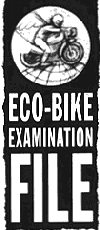
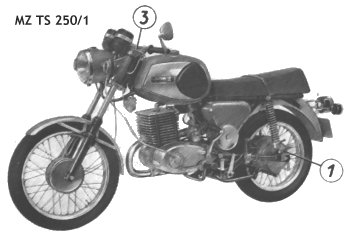 Over the next few years they gradually became more popular and by 1978-1979 they
were considered one of the more serious dispatch bikes. But even then rumours
were beginning to circulate about dodgy main bearings.
Over the next few years they gradually became more popular and by 1978-1979 they
were considered one of the more serious dispatch bikes. But even then rumours
were beginning to circulate about dodgy main bearings.
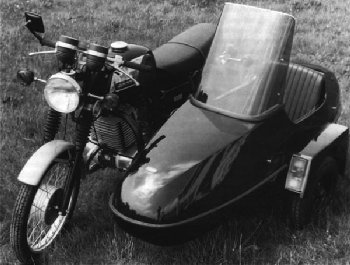 The big weaknesses were the electrics and the front brakes. Despite the glowing
(no pun) account above, the electrics were just not up to the job, providing
weak lights and virtually no horn - an almost fatal combination for dispatching.
I can only assume that a combination of continuous town running and accumulated
dirt and corrosion in the wiring harness caused the lights to fade from their
original brilliance.
The big weaknesses were the electrics and the front brakes. Despite the glowing
(no pun) account above, the electrics were just not up to the job, providing
weak lights and virtually no horn - an almost fatal combination for dispatching.
I can only assume that a combination of continuous town running and accumulated
dirt and corrosion in the wiring harness caused the lights to fade from their
original brilliance.
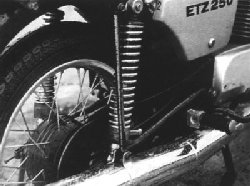 The MZ has the best chain enclosure system I've seen: I'd almost give it full
marks for that alone. Oddly enough, the original chain on the Supa 5 bought new
lasted only about 15,000 miles. A heavy duty 0-ring job lasted only 10,000 but
its replacement, a standard DID, lasted at least 30,000 and, as far as we can
figure out, was never replaced.
The MZ has the best chain enclosure system I've seen: I'd almost give it full
marks for that alone. Oddly enough, the original chain on the Supa 5 bought new
lasted only about 15,000 miles. A heavy duty 0-ring job lasted only 10,000 but
its replacement, a standard DID, lasted at least 30,000 and, as far as we can
figure out, was never replaced.
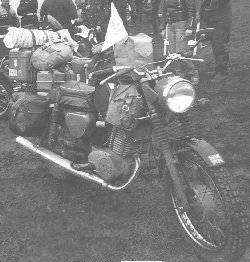
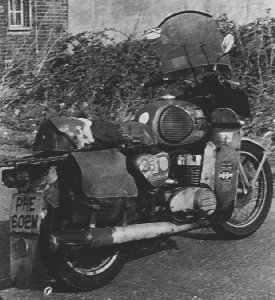 I have on occasion exceeded the criterion here - relatively low power has its
advantages. Avon Supremes can last 12,000 miles on the rear but go a funny shape
towards the end. German tyres wear out quicker but maintain a more reliable
tread profile.
I have on occasion exceeded the criterion here - relatively low power has its
advantages. Avon Supremes can last 12,000 miles on the rear but go a funny shape
towards the end. German tyres wear out quicker but maintain a more reliable
tread profile.
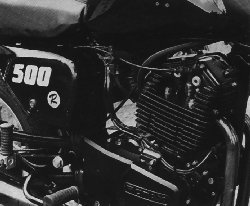 The gearchange return spring can be a pain. Provided you remember to centralise
the lever after each change, however, it is quite possible to carry on riding
the bike with a broken spring.
The gearchange return spring can be a pain. Provided you remember to centralise
the lever after each change, however, it is quite possible to carry on riding
the bike with a broken spring.